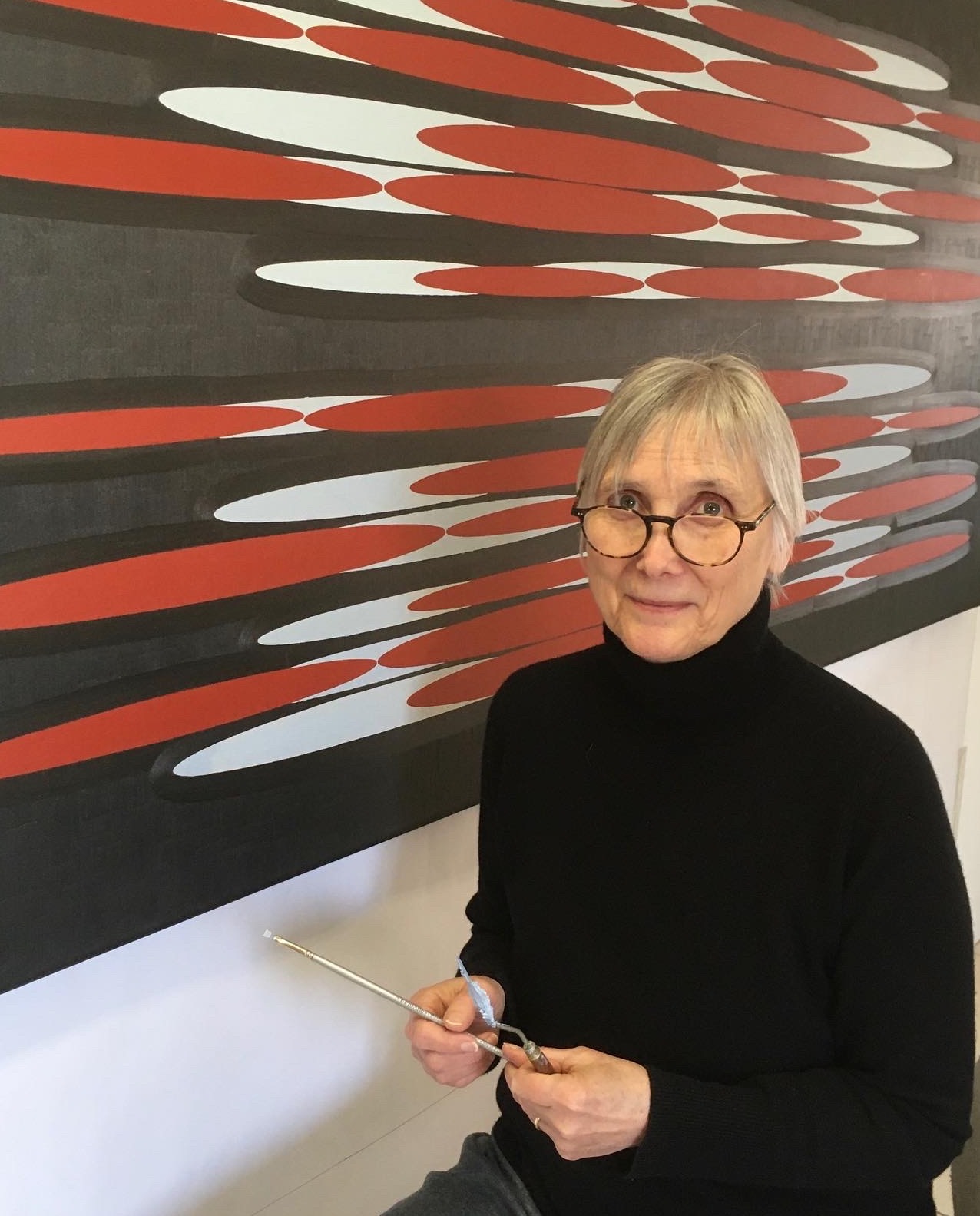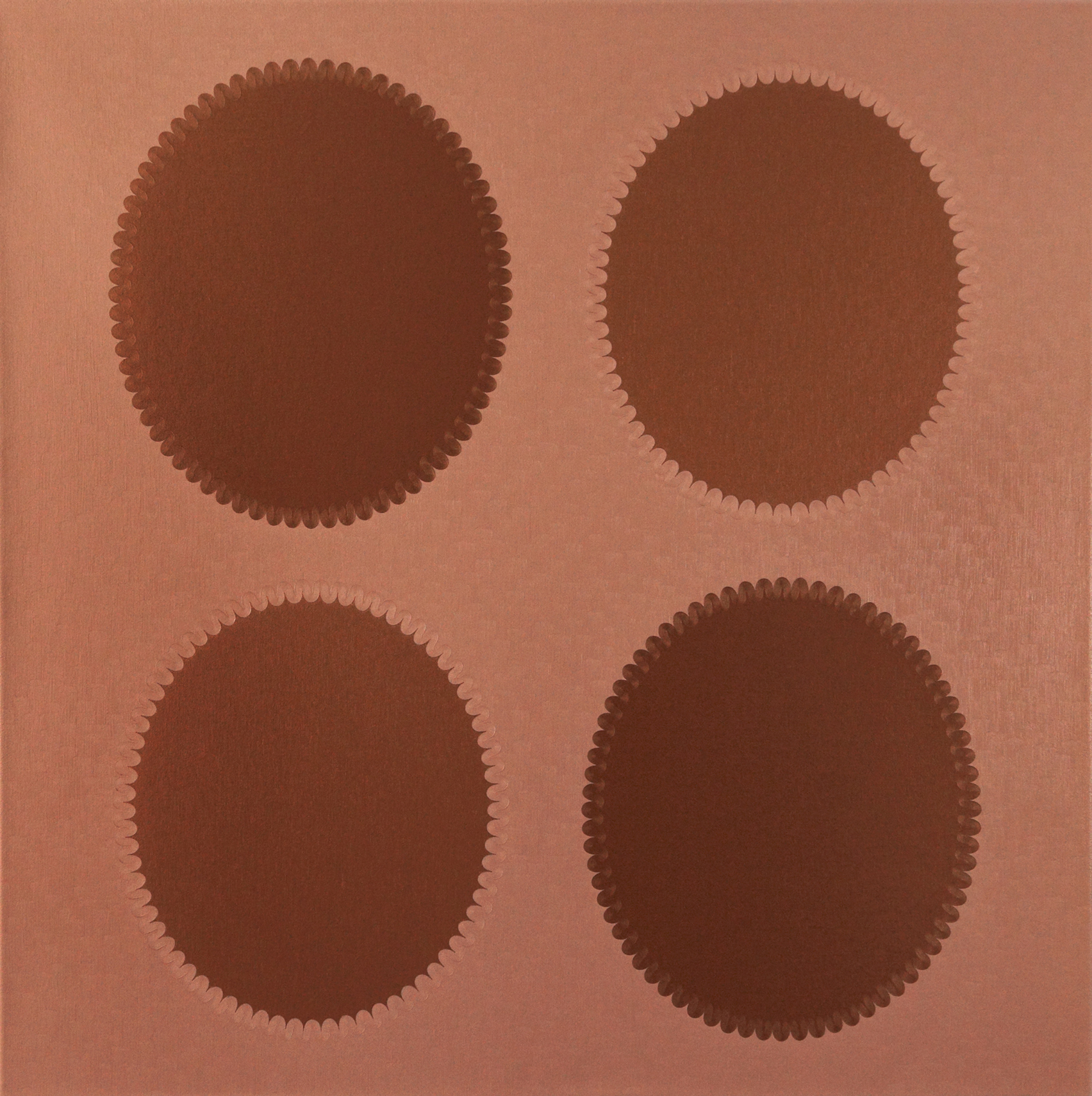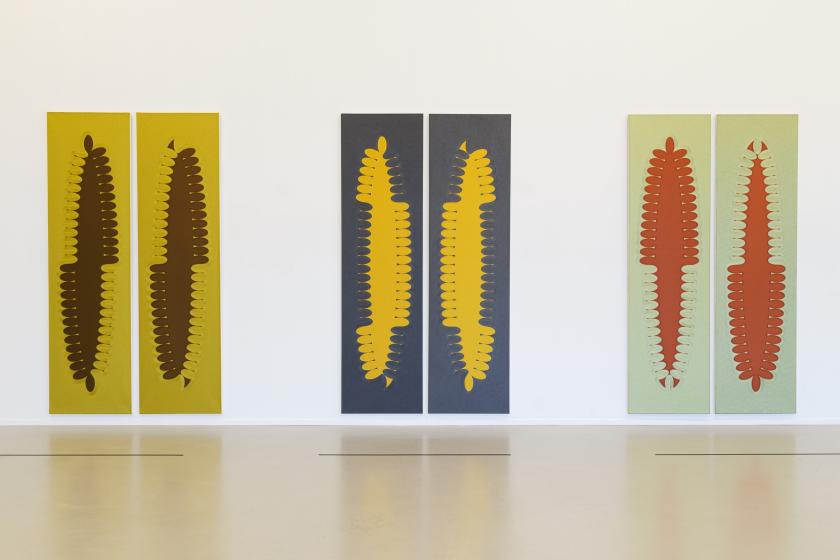In a sixth-floor gallery, flooded with natural light, four paintings and a handful of works on paper compete with views across the River Garonne in Bordeaux. They also vie for attention amidst a history of abstract painting, in which it can feel that everything has been done. The English painter Jane Harris (pictured below right), who sadly passed away in 2022, did find an unexplored niche, however. And that is amply demonstrated by this tight group of her paintings which, we are told, embody a philosophy in which less is more.
In some respects, here less remains less. There is little overt drama or spectacle in these works, and they can seem a bit abstruse. Though large, they are not quite epic. The colours are gently surprising but not utterly arresting. The forms, predominantly ellipses, are less hardwired with bold appeal than the squares, grids or discs of a Malevich, a Mondrian or a Delaunay. The ellipse remained available, perhaps, like something left over from a party which ended in the 1920s. However, even the pioneers of geometric abstraction would have found an interest in what Harris was doing, since she ploughs her furrow with such persistence and conviction.

Harris’s paintings speak with quiet insistence to art historical forebears, but they contain an element some visitors might balk at. Along with ovals, Harris complicates her pictures with non-geometric frills, as if each of her stretched circles had teeth. She flirts with minimalism, prescribing the same vertical template for each of her paintings. Then she flouts this entire convention of painting and sculpture by decorating each of her basic forms with carefully wrought borders that upset the paintings’ rule-oriented premise. It’s as if more is more.
The US art critic Barry Schwabsky has described the effect of this to-ing and fro-ing between the calculating coolness of strictly minimal art and the lively application of painterly ornament as "rococo minimalism". Harris’s lacy fringes are indeed incongruous, as if an antimacassar had been carefully laid across a sculpture by Donald Judd. The trick is anything but cheap, and all the stranger for it. Get close to the surface of one of these awkward ellipses and you soon realise these works are precision engineered. Perfectly blended brushstrokes create exquisite, flowing outlines and elsewhere paint is applied in patient, squared-off tiles.
 This rigour is also knowingly undermined by cheerfully expressive and, frequently, throwaway titles in a way that belie the careful process behind them. Buff and Tan, 2005 (pictured above), Look There, Look There, 2014, or Sidekick and Devil’s Advocate from the Familiars series, 2014-2018 (main picture), are just a few examples from this show. One finds playfulness even in the painter’s central vehicle. Ellipse is a term in which the word "lips" hides in the middle. Conversational titles and intensely perfect brushwork belie the depths these works. Is it English diffidence and self-deprecating humour we find here? Spending time in the Nineties at the London art school Goldsmiths, Harris evolved within an artistic milieu that was given over to shock, confrontation, and immediacy. Her works are a long way from a pickled shark or an unmade bed, but Damien Hirst and Tracey Emin have both returned to painting in later life. They might well admit, Harris was on to something.
This rigour is also knowingly undermined by cheerfully expressive and, frequently, throwaway titles in a way that belie the careful process behind them. Buff and Tan, 2005 (pictured above), Look There, Look There, 2014, or Sidekick and Devil’s Advocate from the Familiars series, 2014-2018 (main picture), are just a few examples from this show. One finds playfulness even in the painter’s central vehicle. Ellipse is a term in which the word "lips" hides in the middle. Conversational titles and intensely perfect brushwork belie the depths these works. Is it English diffidence and self-deprecating humour we find here? Spending time in the Nineties at the London art school Goldsmiths, Harris evolved within an artistic milieu that was given over to shock, confrontation, and immediacy. Her works are a long way from a pickled shark or an unmade bed, but Damien Hirst and Tracey Emin have both returned to painting in later life. They might well admit, Harris was on to something.
Whether ellipses or just lips, these paintings move, take on depth, and speak to the viewer. Squint, and the forms become circles viewed in recession. Get close enough, and the many layers of paint draw you in along the z-axis of the work. Can they speak loud enough to the glut of imagery which characterises screen-based culture? That is a question with which all abstract painters must wrestle today. Many of them will be inspired by Harris who engaged with her chosen form over and over again, until there could be no doubt she owned it.









![SEX MONEY RACE RELIGION [2016] by Gilbert and George. Installation shot of Gilbert & George 21ST CENTURY PICTURES Hayward Gallery](/sites/default/files/styles/thumbnail_125_x_125_/public/mastimages/Gilbert%20%26%20George_%2021ST%20CENTURY%20PICTURES.%20SEX%20MONEY%20RACE%20RELIGION%20%5B2016%5D.%20Photo_%20Mark%20Blower.%20Courtesy%20of%20the%20Gilbert%20%26%20George%20and%20the%20Hayward%20Gallery._0.jpg?itok=3oW-Y84i)





Add comment